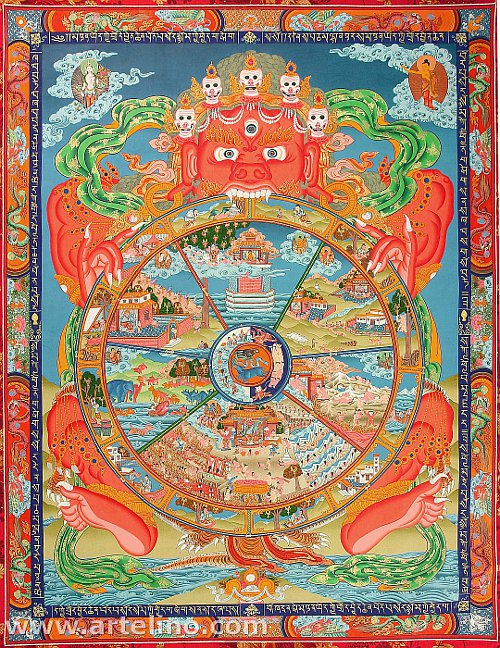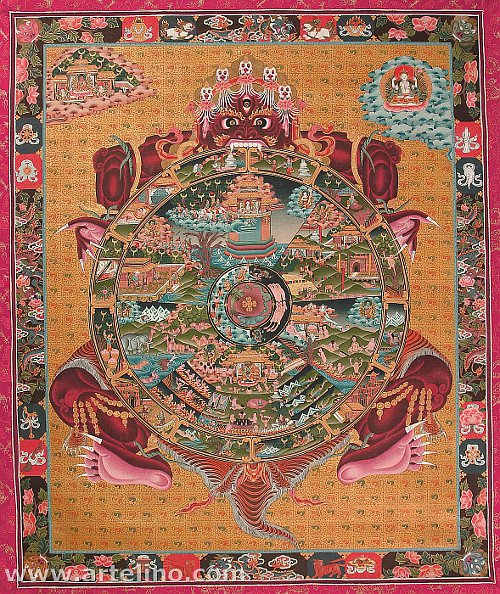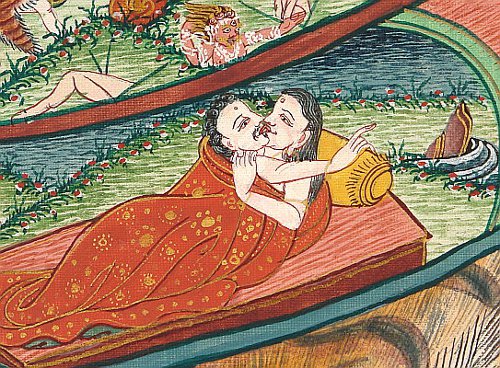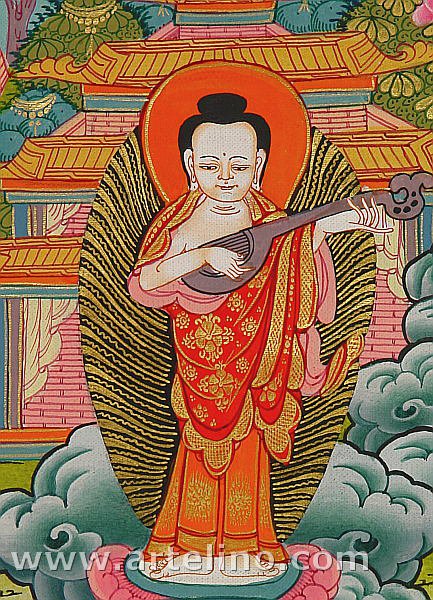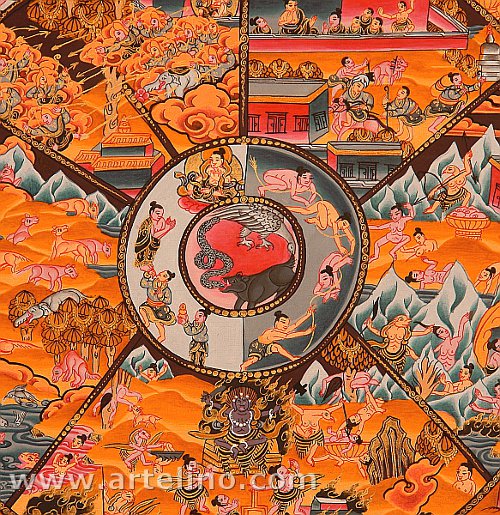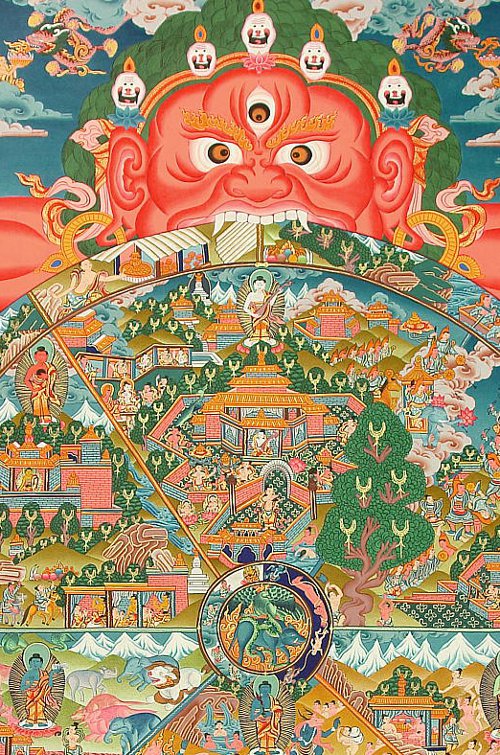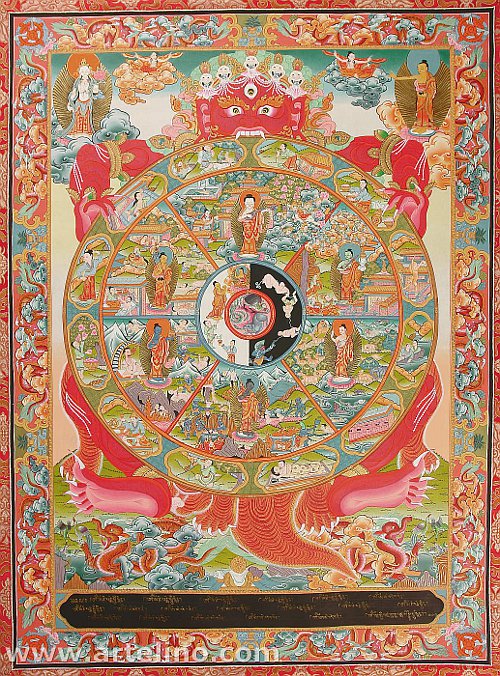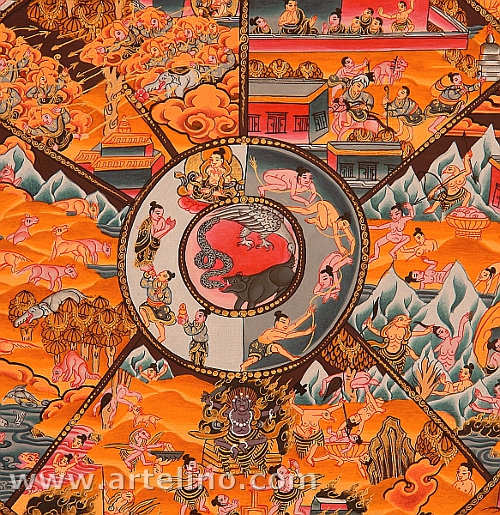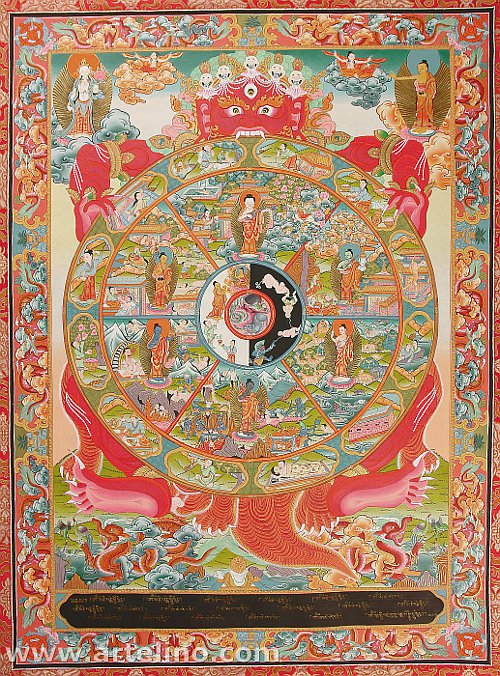| < Prev |
|---|
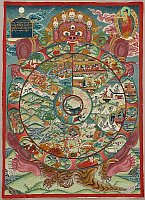 Tibetan thangkas follow iconographic patterns. One of these iconographic subjects is called 'wheel of life'. It shows a huge wheel held by a ferocious monster. This article explains the basics and shows a lot of detailed examples from Tibetan thangkas.
Tibetan thangkas follow iconographic patterns. One of these iconographic subjects is called 'wheel of life'. It shows a huge wheel held by a ferocious monster. This article explains the basics and shows a lot of detailed examples from Tibetan thangkas.
Wheel of Life - Thangka Paintings
Bhavacakra - Wheel of Life
In sanskrit this image of essence of Tibetan Buddhism, held and turned by a dreadful demon (Yama, the god of death?), is called Bhavacakra. It can be translated as 'Wheel of Life', 'Wheel of Existence', 'Wheel of Rebirth', 'Wheel of Suffering' or 'Wheel of Transformation'. According to old Buddhist scripts, the historical Buddha Sakyamuni himself gave the instructions how to draw the 'Bhavacakra'.
Wheel of Life - a Visual Aid for a Religious Message
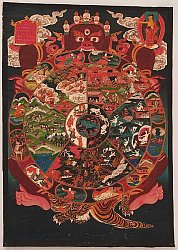 The Buddhist Wheel of Life is the visual demonstration of the essence of Buddhism, the cycle of rebirths and of karma, the belief that causes and effects are the result of one's own deeds in this life.
The Buddhist Wheel of Life is the visual demonstration of the essence of Buddhism, the cycle of rebirths and of karma, the belief that causes and effects are the result of one's own deeds in this life.
Buddhist thangkas are meditation paintings. But they had also a function to get a religious message across. Common Tibetans could not read and write in past centuries. The wheel of life was meant to demonstrate common people the connection of their deeds in their current life to their fates after physical death. Basically the subject of 'Wheel of Life' demonstrates the viewer what he has to face in his next state of rebirth if he behaves good or bad in this life.
In the Christian religion you find similar images created during the medieval age - paintings or murals in churches showing heaven and hell, and thus trying to 'educate' and 'manipulate' the common people for their religious cause.
The teachings of Buddhism are about the suffering in this world and one's own responsibility to improve these conditions and finally overcome the suffering by breaking the continuous cycle of rebirths through nirvana - the state of full enlightenment which ends all suffering.
The Roots of Evil - Hub Section
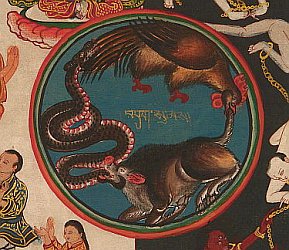 In the very middle you find the figures of a cock, a serpent and a pig (boar) representing lust, hatred and greed. They are also called the "Three Poisons".
In the very middle you find the figures of a cock, a serpent and a pig (boar) representing lust, hatred and greed. They are also called the "Three Poisons".
- Cock = Lust
- Serpent = Hatred.
- Pig = Greed.
These three animals hold themselves at their tails, thus expressing the vicious cycle that these three evils perform.
The White and the Dark Path - Inner Circle
The Inner wheel is divided into the white path of bliss on the left and the dark side on the right that shows the path towards hell. The "bad" guys fall down (right side) in direction of a poor reincarnation, whereas the "good" guys rise upwards (left section) to a better reincarnation. The idea reminds of Christian belief about heaven and hell.
The Five/Six Worlds - Middle Circle
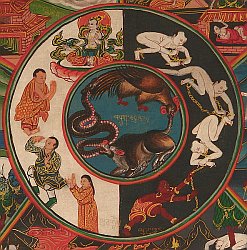 The main sections inside the wheel show the different forms of reincarnation/enlightenment. The ones in the lower area are the "bad" ones like "hell" or "animals". On top are the "better" reincarnations. But even the good/upper reincarnations are not what we would call paradise. Paradise in the meaning of Buddhist religion is "nirvana", the final end to all rebirths and the end of human suffering.
The main sections inside the wheel show the different forms of reincarnation/enlightenment. The ones in the lower area are the "bad" ones like "hell" or "animals". On top are the "better" reincarnations. But even the good/upper reincarnations are not what we would call paradise. Paradise in the meaning of Buddhist religion is "nirvana", the final end to all rebirths and the end of human suffering.
The worlds (realms, sections) are:
- The world of Devas (gods)
- The world of Asuras (semi-gods, titans).
- The world of Humans.
- The world of Animals.
- The world of Pretas (hungry ghosts).
- The world of Hell.
One can find thangkas with 5 (Devas and Asuras combined) and with 6 worlds (more common today).
According to later types of Buddhist belief one can transform into nirvana (the ultimate paradise) from each of these worlds directly. In other words, it is not necessary to "work one's path up" through the different worlds.
The Twelve Interdependent Causes and their Effects - Outer Rim
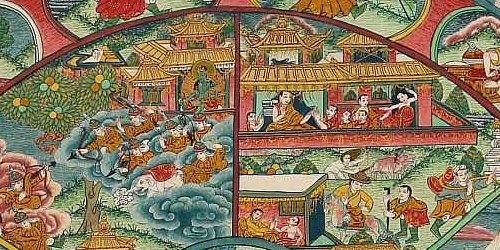
The outer rim of the wheel is separated into 12 parts, showing seemingly scenes from every-day-life. These scenes represent each one of the twelve interdependent causes and effects.
- Ignorance. Represented by a blind old woman.
- Volitional action or conditioning. Represented by a potter at work.
- Consciousness. Represented by a monkey in the tree eating fruit.
- Name and form. Represented by a boat with a row-man.
- Six sensory organs (i.e. eye, ear, nose, tongue, body, and mind). Represented by a house with 5 windows (eye, ear, nose, tongue, body) and one door (mind).
- Contact or touch. Represented by lovers.
- Sensation. Represented by a man with an arrow in his eye.
- Desire, craving, thirst. Represented by a man drinking wine,
- Grasping. Represented by a man collecting fruit.
- Becoming or existence. Represented by a woman expecting a child.
- Birth. Represented by the birth of a child.
- Decay and death. Represented by a corpse carried to the funeral.
The images representing the twelve causes are not compulsory in this form. One may find variations.
Thangka Gallery - Wheel of Life
Here are a few more examples of Tibetan 'Wheel of Life' thangkas.
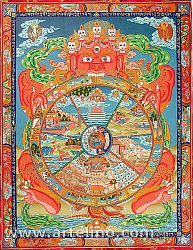
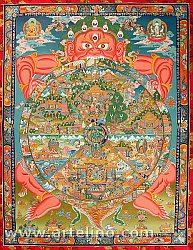
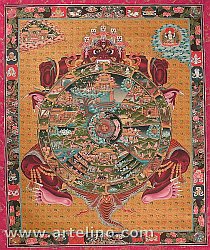
Wheel of Life Thangka - Video
An unknown Nepalese (thangka painter?) explains the basics in front of a Wheel of Life thangka. He speaks a bit too fast and the sound is a bit hard to understand. You may have to play it more than once. Not important. It is a good explanation.
As far as I can judge from this distance, the thangka seems to be of good quality. The style of the thangka is typical for early 21st century. How do I recognize that?
It is easy. Look at the decorative border around the thangka and the black band - with sanskrit inscriptions in golden color - on bottom of the thangka. Earlier thangkas until the late 20th century did not have this decorative border which you now can find not only on 'Wheel of Life' thangkas, but with other iconographic subjects as well.
References
Dharmapala Centre has a good explanation of the Wheel of Life iconography.
Dieter Wanczura, January, 2010




